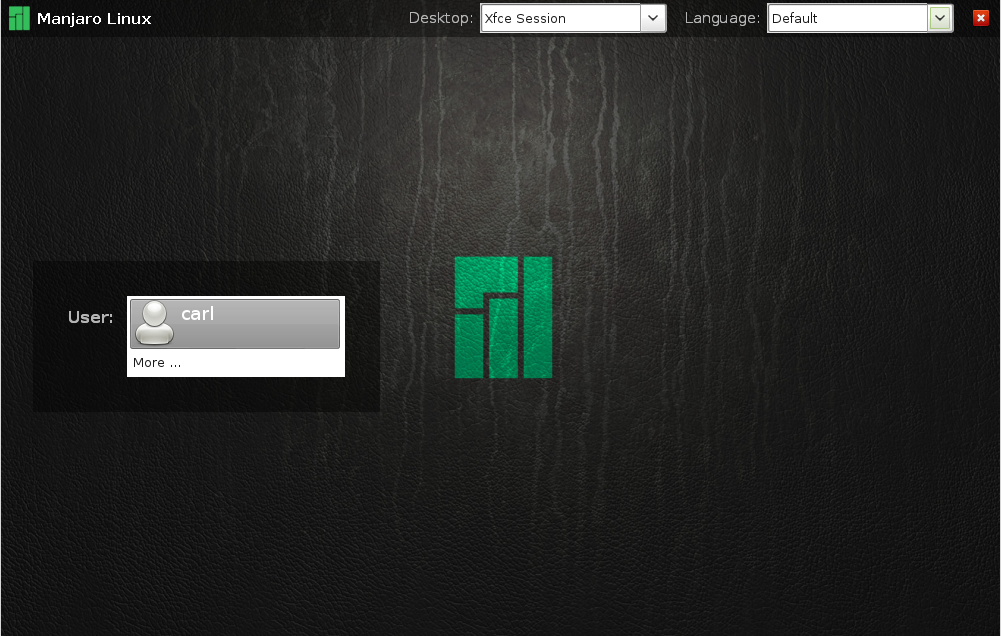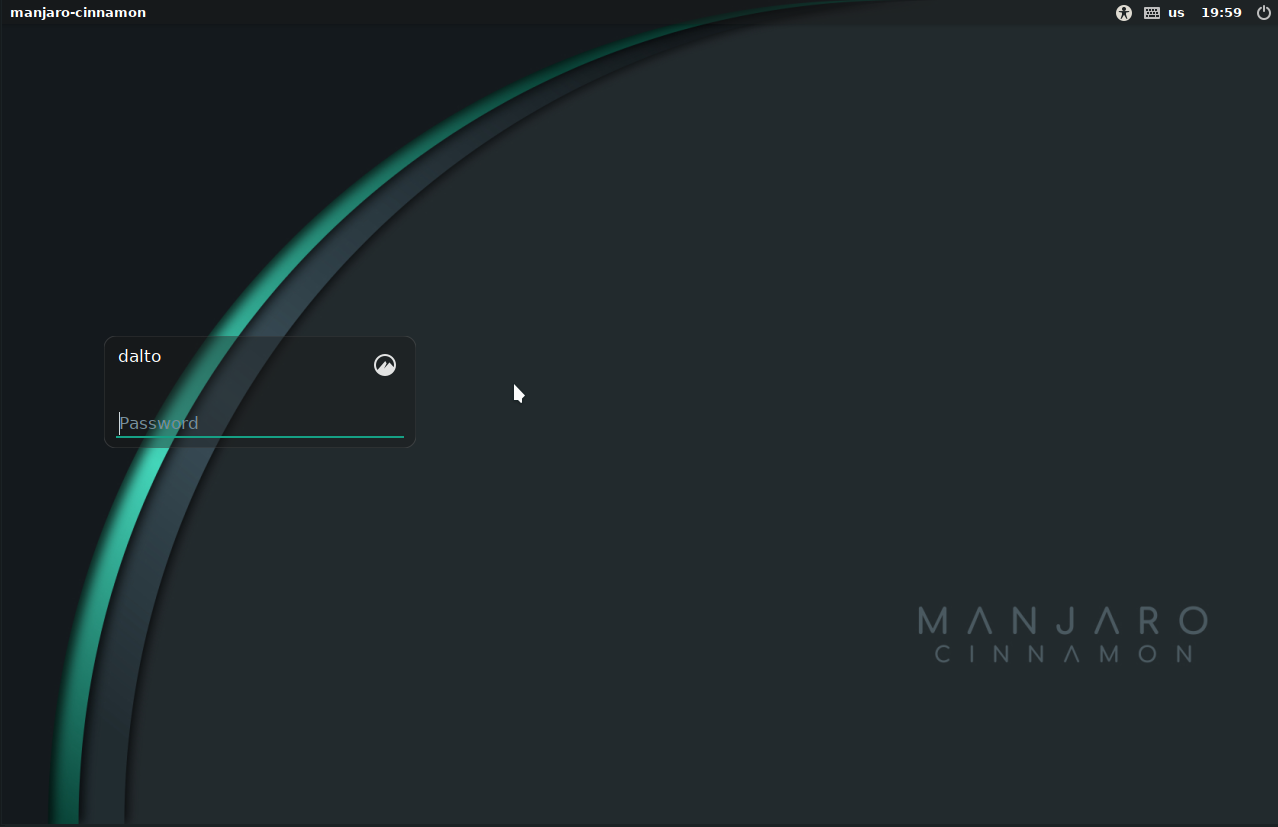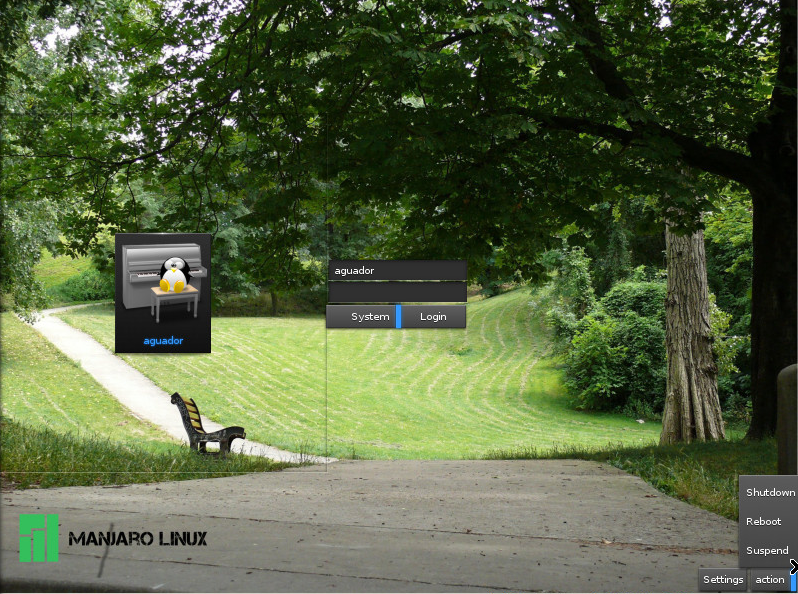Difference between revisions of "Install Display Managers"
Views
Actions
Namespaces
Variants
Tools
imported>Dalto (Update entrance) |
imported>Dalto (Revamp lightdm section) |
||
| Line 56: | Line 56: | ||
=LightDM= | =LightDM= | ||
[[File:Lightdm2019-1.png|thumb|left|375px]] | |||
[https://github.com/CanonicalLtd/lightdm LightDM] is a light display manager with minimal dependencies. | |||
==Installing LightDM== | |||
LightDM can be installed with: | |||
pamac install lightdm | |||
sudo | To enable LightDM as the default display manager use: | ||
sudo systemctl enable lightdm.service --force | |||
==Installing a Greeter== | |||
With LightDM, you also will need to install and configure a greeter. If you don't install a greeter, it won't work. | |||
There are a lot of greeters for LightDM. We will cover two of the greeters most commonly used by Manjaro editions. | |||
====Slick Greeter==== | |||
Install the greeter and the configuration tool: | |||
pamac install lightdm-slick-greeter lightdm-settings | |||
Edit the file '''/etc/lightdm/lightdm.conf'''. For instructions on how to edit a file owned by root see [[Viewing_and_editing_configuration_files|this guide]]. | |||
Locate the section '''[Seat:*]'''. Within that section locate the line containing '''greeter-session=''' and replace the entire line with | |||
greeter-session=lightdm-slick-greeter | |||
The slick-greeter ships with a working configuration file but you can optionally run the "Login Window"(lightdm-settings) application and customize the greeter in many ways. | |||
====GTK Greeter==== | |||
Install the greeter and the configuration tool: | |||
pamac install lightdm-gtk-greeter lightdm-gtk-greeter-settings | |||
Edit the file '''/etc/lightdm/lightdm.conf'''. For instructions on how to edit a file owned by root see [[Viewing_and_editing_configuration_files|this guide]]. | |||
Locate the section '''[Seat:*]'''. Within that section locate the line containing '''greeter-session=''' and replace the entire line with | |||
greeter-session=lightdm-gtk-greeter | |||
The gtk greeter ships with a working configuration file but you can optionally run the "LightDM GTK+ Greeter Settings"(lightdm-gtk-greeter-settings) application and customize the greeter in many ways. | |||
Revision as of 01:01, 22 May 2019
Overview
Display Managers are used to provide login screens, and therefore serve as protective security barriers to prevent unauthorised access to your system. They are also referred to as Login Managers. As with different desktop environments, different display managers will require different system resources to run, and will provide their own unique styles, interfaces, and features. Commonly shared features - particularly in respect to the selection of display managers listed below - include customisation/theming, automatic login, and the selection of multiple desktop environments.
GDM
GDM - the Gnome Display Manager - is designed for use with Gnome 3. It supports theming, automatic login, and the automatic detection and use of multiple desktop environments. Specifically for those using Gnome 3. GDM is typically only paired with a Gnome Desktop Environment because GDM depends on a large amount of the Gnome desktop as dependencies.
GDM can be installed by entering the following command:
pamac install gdm
To enable GDM as your default display manager use the command:
systemctl enable gdm.service --force
To install the Manjaro specific theming for GDM you can use the command:
pamac install manjaro-gdm-theme
LXDM
LXDM - the Lightweight X-Windows Display Manager - is designed for use with any desktop environment. It supports theming, automatic login, easy selection of multiple languages, and the automatic detection and use of multiple desktop environments.
To install LXDM, enter the command:
pamac install lxdm
To enable LXDM as your default display manager use the command:
sudo systemctl enable lxdm.service --force
SDDM
SDDM is a relatively new and lightweight QML-based display manager with minimal dependencies for use with any desktop environment. It supports theming, automatic login, and the automatic detection and use of multiple desktop environments.
To install SDDM, enter the command:
pamac install sddm
To enable SDDM enter the command:
sudo systemctl enable sddm.service --force
LightDM
LightDM is a light display manager with minimal dependencies.
Installing LightDM
LightDM can be installed with:
pamac install lightdm
To enable LightDM as the default display manager use:
sudo systemctl enable lightdm.service --force
Installing a Greeter
With LightDM, you also will need to install and configure a greeter. If you don't install a greeter, it won't work.
There are a lot of greeters for LightDM. We will cover two of the greeters most commonly used by Manjaro editions.
Slick Greeter
Install the greeter and the configuration tool:
pamac install lightdm-slick-greeter lightdm-settings
Edit the file /etc/lightdm/lightdm.conf. For instructions on how to edit a file owned by root see this guide.
Locate the section [Seat:*]. Within that section locate the line containing greeter-session= and replace the entire line with
greeter-session=lightdm-slick-greeter
The slick-greeter ships with a working configuration file but you can optionally run the "Login Window"(lightdm-settings) application and customize the greeter in many ways.
GTK Greeter
Install the greeter and the configuration tool:
pamac install lightdm-gtk-greeter lightdm-gtk-greeter-settings
Edit the file /etc/lightdm/lightdm.conf. For instructions on how to edit a file owned by root see this guide.
Locate the section [Seat:*]. Within that section locate the line containing greeter-session= and replace the entire line with
greeter-session=lightdm-gtk-greeter
The gtk greeter ships with a working configuration file but you can optionally run the "LightDM GTK+ Greeter Settings"(lightdm-gtk-greeter-settings) application and customize the greeter in many ways.
Entrance
Entrance is a configurable DM designed for the Enlightenment desktop environment which allows selection of multiple themes, icons, and the enabling of virtual keyboards. The default installation offers a wallpaper with randomly displayed icons for each user account, although a fixed icon can be specified and custom icons compiled and added. When multiple Entrance themes are installed it is possible to have a default theme displayed on startup and individual themes that appear for each user as they begin login.
Entrance is available in the Arch User Repository (AUR) and may be installed using the following command:
pamac build entrance-git
To enable Entrance as the default display manager run the command:
sudo systemctl enable entrance.service --force
Plymouth
Manjaro no longer ships with Plymouth but for those using Plymouth you should enable the Plymouth specific services instead of the services mentioned above. Specifically, these are:
gdm-plymouth.service lightdm-plymouth.service lxdm-plymouth.service sddm-plymouth.service


